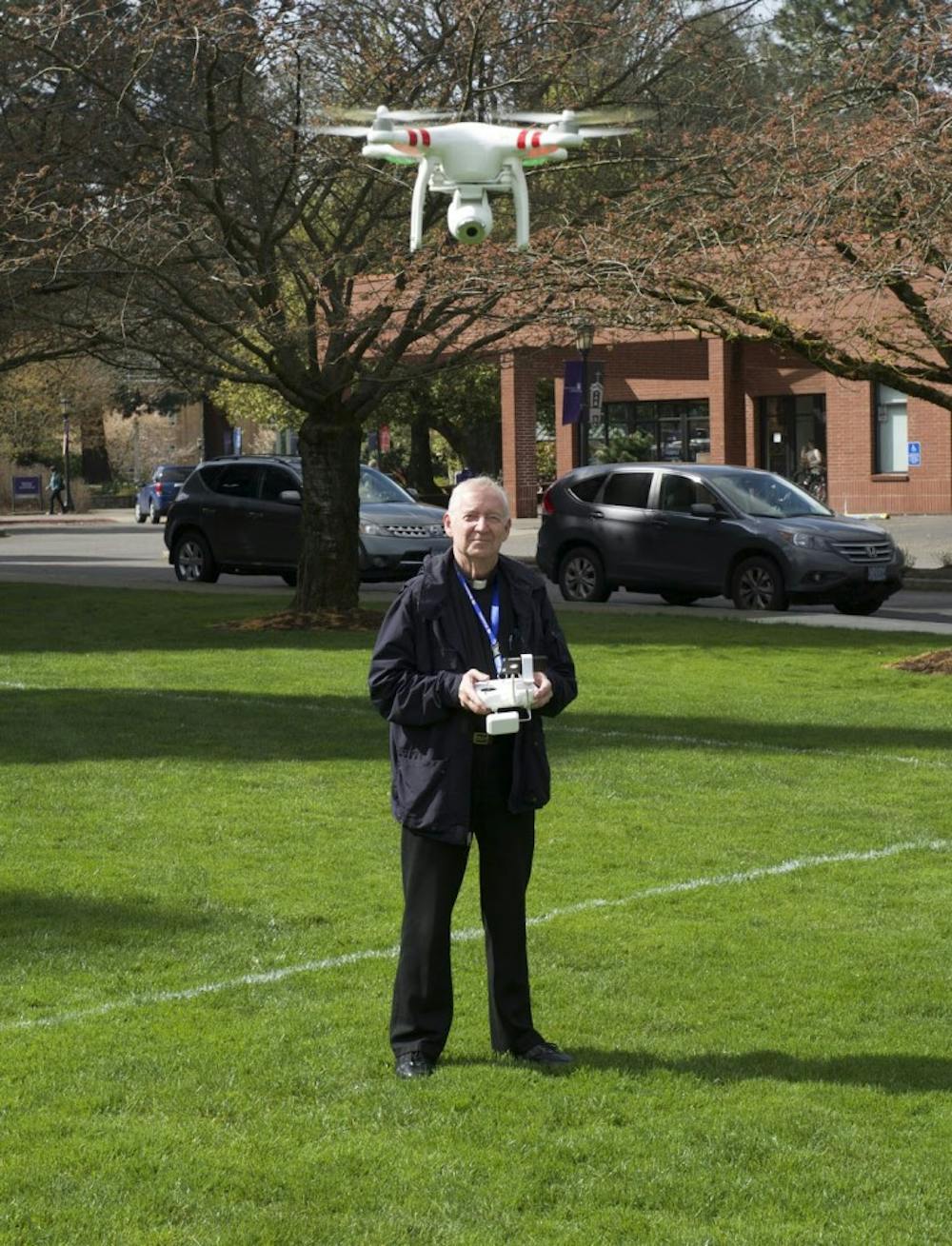Nastacia Voisin |
Fueled by their portrayal in the media as sinister, free-floating weapons and surveillance tools, drones are a conversational hotspot in a global discussion on technology ethics. They make headlines as killers in the Middle East, and raise concerns about how unseen eyes above can undermine our right to privacy.
But they are also being promoted as pioneering research tools by academics like environmental science professor Fr. Ronald Wasowski.
“There are some amazing research opportunities,” Wasowski said. “We’ve been able to get very good both scientific and documentary still photos and videos.”
Tucked into Buckley Center 211 is a trio of the ubiquitous flying machines, a small fleet of drones the environmental science department has been accumulating since 2010.
Five years ago Wasowski, environmental science professor Steve Kolmes and chemistry professor David Alexander (who passed away in 2013) won a grant to purchase two Draganflyer X6s drones.
At the time, these six-propeller drones were virtually prototypes that came with three interchangeable imaging systems: a still camera, a digital video camera and thermal infrared camera.
Wasowski, Kolmes and Alexander wasted no time in hauling these expensive machines (each in the $20,000 range) to the western slopes of Mt. Hood. They used the drones to measure water temperature in four streams as part of their research on salmon spawning habitat quality.
As the alternative way of capturing those aerial shots was leaning out of a helicopter door with a camera, Wasowski said they were excited to try out the drones.
Unfortunately, the camera on the Draganflyer X6 was unable to capture the data they needed. But last March, UP bought a third drone – a Phantom 2 Vision – which is smaller, lighter and a more technologically advanced model.
Last summer, Wasowski and retired theology professor Fr. Richard Rutherford used the Phantom during a three-week expedition on the Spanish island of Mallorca. They successfully used it to visually document aerial views of early Christian archeological sites.
The advantage of having mechanical eyes above, Wasowski said, is that they collect data that would be invisible from the ground.
“We’re convinced that there are archeological features hidden just below the surface,” he said.
One way of finding these hard-to-spot sites is by looking for vegetation irregularities, caused by water pools or drains from buried artifacts, which stunts plant growth. The drone can also use an infrared camera to find hidden burial sites, as it will detect heat differences between the island’s bedrock and the sandy graves once the sun sets.
Using the Phantom’s camera system, Wasowski and Rutherford plan to try both of these tactics when they return to Mallorca this July.
“We have very high hopes,” Wasowski said. “To have these cameras miniaturized to the point that we can fly them on a drone is really exciting.”
In part to introduce students to the research advantages of drones, last fall Wasowski taught a one-credit lab for building and flying remote-controlled aircrafts. Along with constructing two fixed-winged planes and learning the basics of aerodynamics, the five students who enrolled had a shot at navigating one of UP’s drones.
According to senior Joshua Bates, once you get the hang of it, flying a drone is sheer fun.
He described the delight of watching the Phantom 2 Vision drone – a compact machine roughly the size of laptop – fly under his command. As his fingers danced between the manual cyclic controls, rudder control and throttle, the drone whirred through Howard Hall’s upper gym, avoiding clipping basketball players or the ceiling before Bates grounded it.
“I loved it,” said Bates, a mechanical engineering major. “I’ve done similar things in the past as a kid, flying anything that could fly, so it was really fun to learn all over again.”
Along with the hands-on practice with drones, Wasowski brought ethical and legal discussions to his lab course.
“A huge issue is not safety, but privacy,” he said.
The sophisticated imaging tools drones can carry could potentially be used to track or spy on people.
In part because of these fears, the regulation of drones in U.S. airspace is still patchwork, with push and pull between innovators and regulators. For over 10 years the Federal Aviation Administration (FAA) has been hammering out specific laws and policies.
One of the problems with this stalling is that while drones differ in size, capacity and purpose, they get bundled into similar categories. For instance, the tiny Phantom drone is legally categorized with predator drones – which weigh thousands of pounds and can fire air-to-ground missiles.
“It’s uber-control,” Wasowski said. “And there are all kinds of ambiguities and gray areas.”
On Feb. 15, the FAA released a Notice of Proposed Rulemaking for small, unmanned aircrafts, opening the door for public comment on future rulemaking. But the road to reasonable regulation, Wasowski said, might take some time.
For sophomore Quentin Ward, who took the class last fall, those conversations helped shape his perspective on the principles behind drones.
“Drones are a touchy subject,” Ward said. “So we talked about it extensively. The media kind of portrays them negatively, but once you understand them, I believe that some of that fear will subside.”
Ward added that even if a few people abuse the advantages a flying machine could give them, most people – himself included – just want to explore the technology. In fact, he enjoyed flying drones during class so much that he bought his own over spring break.
“I definitely fell in love,” Ward said. “I just want to keep flying.”
Nastacia Voisin is a reporter and copy editor for The Beacon. She can be reached at voisin15@up.edu.








